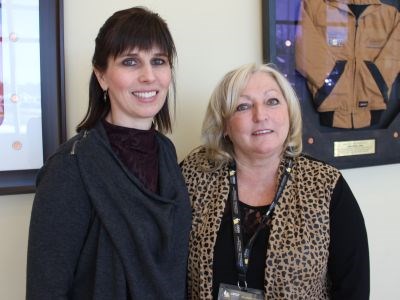Janice Martell knew that going national with her quest to get compensation for miners who had inhaled McIntyre Powder would get some attention, but she was bowled over by the response after CBC aired her story earlier this year.
On Jan. 29, CBC’s Fifth Estate program broadcast Miner’s Daughter, a follow-up to the show’s original look at the issue, Powder Keg, which aired in 1979.
“Since the Fifth Estate aired, I’ve been spending virtually every night, several hours a night, just answering peoples’ messages,” Martell marvelled.
Some contacts have simply been wishing her well in her endeavour. But dozens of miners and their relatives have contacted her asking how they can get on her voluntary registry, which chronicles the health issues of mine workers who were exposed to McIntyre Powder during the course of their employment.
“I’m hearing from people that I otherwise would not have heard from had it not gone national,” Martell said. “So that’s been really good.”
McIntyre Powder — finely ground aluminum dust — was administered to miners in mines across Canada from 1943 to 1979.
Developed by mine executives as a preventive measure against silicosis, the practice was discontinued after preliminary tests showed not only that it failed as a prophylactic, but that miners who inhaled the dust demonstrated greater cognitive impairment. No follow-up research has been done after the practice stopped.
There’s never been a causal relationship made between McIntyre Powder and neurodegenerative diseases like Parkinson’s, Alzheimer’s and amyotrophic lateral sclerosis (ALS), but Martell hopes that will change this spring.
On May 11 and 12 in Timmins, the United Steelworkers (USW) union, in conjunction with the Occupational Health Clinics for Ontario Workers (OHCOW) and the Office of the Worker Advisor (OWA), is holding an intake clinic to glean more information from workers who’ve been impacted by McIntyre Powder.
Sylvia Boyce, the USW’s health and safety co-ordinator for District 6, said the union answered Martell’s call for greater research into the issue because the health and safety, and protection of all workers is a union priority.
“If you’re able to identify the occupational diseases, illnesses and injuries, only then are you able to prevent or control them,” Boyce said.
“That’s really what our ultimate goal is: we want to be able to seek compensation for those workers who suffered adverse health effects that were related to their occupational exposure.”
Boyce said the union believes there could be a link between McIntyre Powder and neurodegenerative disease, and hopes this intake clinic will provide information that offers a more solid connection between the two.
She also believes the information gleaned from miners at the clinic could reveal links to additional work-related diseases or illnesses that are not currently recognized by the Workplace Safety and Insurance Board (WSIB), which doles out compensation for impacted workers.
“What is clearly known, and has always been known to us all here, is that the numbers do not really portray the real picture of the amount of people that have been exposed or are suffering from occupational diseases, or that have died, because, sadly, people don’t make that link to the workplace,” Boyd said.
“So many of these occupational diseases and deaths have been unrecognized and they’re not reflected in statistics, and we believe there are thousands upon thousands that have never been actually considered.”
More than 200 people are currently on Martell’s registry, and she’s expecting big numbers for the clinic.
The Ontario Public Service Employees Union (OPSEU), the union to which Martell belongs, is contributing $3,000 to pay for a motor coach to bring miners in Elliot Lake to Timmins for the clinic, and people from as far as British Columbia and North Carolina have confirmed their attendance.
After registration, clinic attendees will visit a number of stations where a team of occupational hygienists, nurses and doctors will take down information about the miners’ experience with aluminum dust, record the health issues they experience, and conduct body mapping to show where on their body they experience health issues.
Workers don’t have to be on Martell’s registry to attend. Any miner who was exposed to the dust and suspects he has health-related issues is welcome.
It’s OHCOW’s mandate to conduct diagnostic assessments of medical conditions people think are associated with their work, said Dave Wilken, OHCOW’s chief operating officer.
“We’re very committed as an organization to seeing everybody,” he said of the two-day clinic.
OHCOW is approaching the clinic without assumption about its potential results, but will look at the scientific evidence to make any conclusions, Wilken said.
But he concedes that there’s little information out there now about the issue and it’s a worthy area of study.
“A lot of people have had concerns about this over a long period of time, but it’s not been investigated, although it seems like something that obviously should have been investigated more than it was,” he said.
Regardless of the clinic’s outcome, change is already underway.
Miners used to remain silent about their time in the mines, but the airing of the Fifth Estate piece has kickstarted discussions about mine work, Martell said.
Formerly tight-lipped miners who never spoke about their jobs are opening up about the conditions in the mines and the psychological effects left over by working underground.
“It’s really starting conversations, and conversations in non-mining families, conversations outside Northern Ontario,” Martell said. “There’s been a real shift.




